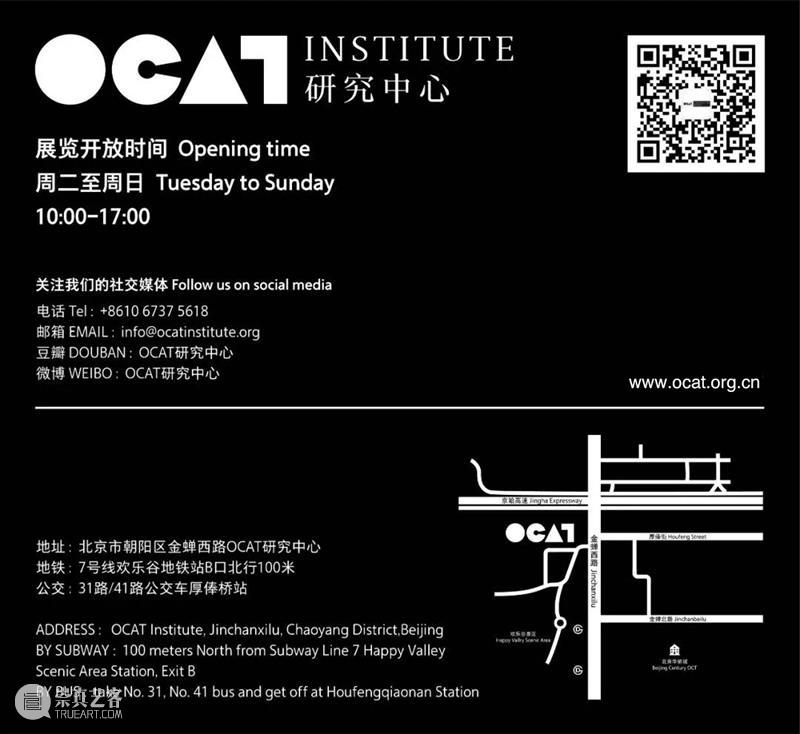

Seven Questions: A Survey of Art Ecosystem of Southern China in the New Century
Opening: 2022.6.11 15:00–17:00
Duration: 2022.6.11–8.14
Address: OCAT Institute, Jinchanxilu, Chaoyang District, Beijing
Curator: Fan Lin
Artists: Hundreds Islands Project, Yangjiang Group, Huang Jingyuan, Huang Xiaopeng, Jiū Society, Observation Society, Du Zhongjian, Duan Jianyu, Qin Jin, Zhong Jialing, Chen Tong, Question Squad: Liu Qingyuan X Fan Lin
Organizer: OCAT Institute
Support: OCT Group Co., Ltd.
Thanks: OCT Northern Group
From 11 June to 14 August 2022, OCAT Institute will present the exhibition "Seven Questions: A Survey of Art Ecosystem of Southern China in the New Century". Curated by Professor Fan Lin from the Art and Humanities School at Guangzhou Academy of Fine Arts, the exhibition presents 15 pieces/groups of works and multiple publications created by art practitioners, organizations, and institutions that have participated in the practice of contemporary art in southern China in one way or another.
In this research project, the term “southern” refers to a concept in cultural geography. Influenced by a combination of factors including geographical environment, time, events, international exchanges, as well as the changes and developments of social structures, the concept “southern China” has developed a characteristic of diversities and complexities since the beginning of the new century. Contemporary art of southern China is an important way to understand the contemporary attributes of the culture, social structure and ecosystem of the South. Thus, in addition to an exploration of the art ecosystem of this delineated geographical area, this exhibition, "Seven Questions: A Survey of Art Ecosystem of Southern China in the New Century", will also pay special attention to the unique significance implied by the distinguished political geography and cultural context of this region.
Fan Lin, the curator of this exhibition, has long been concerned herself with the art ecosystem of the Pearl River Delta, and has been involved in the contemporary artistic practices of southern China. After an in-depth investigation into the art ecosystem of southern China, she poses seven questions based on a variety of historical facts among art spaces, events, artistic practices and communications in this region. The questions present the ways of practice and thinking of individuals, groups or institutions under the context of contemporary art in southern China:
I. Where is the localness located?
II. What are the approaches to education and self-education?
III. Is creative co-living possible?
IV. How do practitioners of multiple identities carry out artistic practices?
V. What does "suspension" mean?
VI. Why do artists write?
VII. How to motivate knowledge production?
These seven questions form the seven sections of the exhibition, unfolding a history of contemporary issues of southern China. Each artwork is a clue that leads to an insight into the ideas behind art practices. The seven sections are connected via Liu Qingyuan's woodcut prints series of the same name, “Seven Questions”, which in a way, represents the independent position and growth consciousness of the art ecosystem of southern China, as well as a questioning of the art system as a whole.
OCAT's origins lie in southern China. The contemporary art ecosystem of southern China has been the soil on which OCAT has lived, and it remains the focus of its attention for a long time. OCAT Institute, as a Beijing-based branch of the OCAT Museums, is oriented towards the study of art history. It has taken the study of exhibition history about Chinese contemporary art as one of its clues in its archival research since the inception. This exhibition is not only an attempt at historically grounded research on modern and contemporary Chinese art, but also a continuation of OCAT Institute's research on the history of exhibitions and art historiography. It is hoped that the exhibition will become a window through which audiences in Beijing (so much as in northern China) can get to know the development of the art ecosystem of southern China, therefore achieving a conversation and interaction between different cultural regions.
This exhibition seeks to describe the various connections between the changing role of art and the developments in social, political, and economic areas in recent years. They outline different situations regarding organizational structures, art practices, localness and growth of various art institutions in southern China that paralleled the growth of OCAT. The entire research project will take the form of an exhibition and a series of dialogues. Apart from documenting and presenting the results of existing artistic practices and knowledge production, sorting out the threads of art phenomena that had taken place, and outlining the multiple layers of art organizations, this project strives to establish connections between various phenomena. It aims to stimulate new thoughts about artistic practices and research on contemporary art from both the public and the academic.
The exhibition and guide tour will open at 3pm on 11 June 2022 with a staff-guided tour both on the site and live via OCAT Institute's channel on WeChat.
Notice to Visitors
According to the government’s instructions on conducting regular epidemic prevention, visitors to the exhibition and library in OCAT Institute please scan the following code to make a reservation.

On the day of visit, please present the reservation code and scan the QR code to register on the mini-program “Beijing Health Kit”. Only visitor with normal real-time Health Code and negative COVID test result within 72-hour could enter. Please also cooperate with body temperature measurement and note that if the body temperature exceeds 37.3℃ or there are any abnormal symptoms such as coughing and shortness of breath, please do not enter. Thanks for your understanding. If you feel unwell after admission, please contact the staff.
Please wear a mask throughout the queue and visit, do not gather, follow the staff instructions to ensure orderly and safe visits.

The OCAT Institute is an independent non-profit research center dedicated to the history of art and its related discourses. It is also an integral part of the OCAT Museums. The Institute has three main areas of activity: publication, archive, and exhibition. The scope of its research encompasses Chinese art from antiquity through the modern and contemporary period. More specifically, it investigates artists, artworks, art movements, exhibitions, aesthetic discourses, as well as art institutions, publications, and other aspects of art’s overall ecology. It will establish a research archive and facilitate dialogue and exchange between China and abroad. In addition, it serves as an exhibition platform in Beijing.
The OCAT Institute aims to establish a paradigm of valuation, a framework of academic investigation, and a unique set of methods, for historically grounded research on modern and contemporary Chinese art. Its scholarly vision has at its core: knowledge, intellect, and research. It seeks to forge connectivities between traditional art history and research on modern and contemporary art, and support the translation and publication of critical works on art history. Through an interdisciplinary approach that bridges contemporary art research, critical theory, and the history of ideas and visual culture, it promotes an integrated methodology and an open spirit of academic research.



已展示全部
更多功能等你开启...





 分享
分享